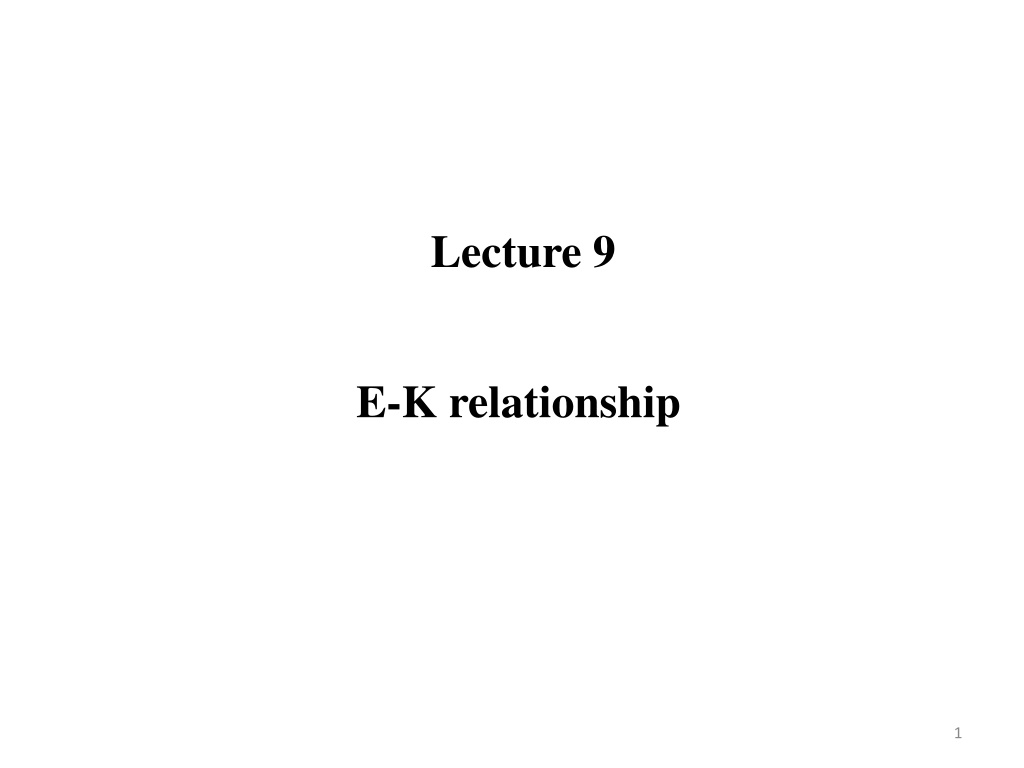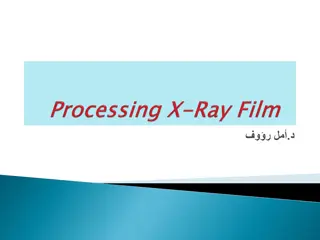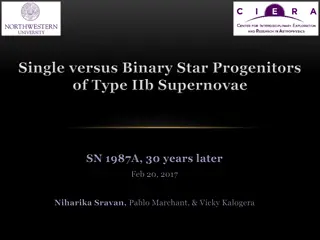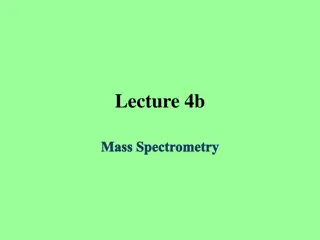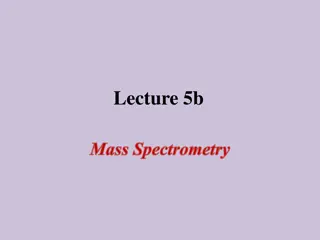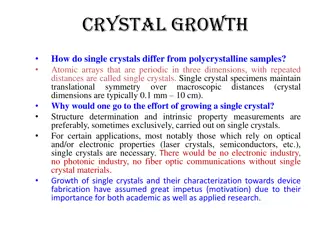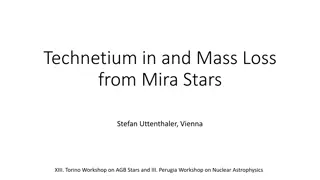Understanding Effective Mass in Crystals: Insights and Applications
The concept of effective mass in crystals delves into how electrons interact with the lattice potential, leading to altered particle masses that affect their behavior. This phenomenon is crucial in applying electrodynamics equations to charge carriers in solids, where the electron mass can differ from the free electron mass. By exploring equations related to effective mass, such as acceleration and momentum, scientists can grasp the nuances of electron dynamics in periodic structures.
Download Presentation

Please find below an Image/Link to download the presentation.
The content on the website is provided AS IS for your information and personal use only. It may not be sold, licensed, or shared on other websites without obtaining consent from the author. Download presentation by click this link. If you encounter any issues during the download, it is possible that the publisher has removed the file from their server.
E N D
Presentation Transcript
Lecture 9 E-K relationship 1
Recap The current is due to positively charged particles associated with the empty states in the almost-filled band. The electrons in a crystal are not free, but instead interact with the periodic potential of the lattice. An electron in crystal may behave as if it had a mass different from the free electron mass m0. The effective mass of an electron (m*) in a solid could be different from the rest mass (m0). The effective mass can be larger or smaller than the rest mass. 2
Effective Mass The electrons in a crystal are not free, but instead interact with the periodic potential of the lattice. In applying the usual equations of electrodynamics to charge carriers in a solid, we must use altered values of particle mass. We named it Effective Mass. An electron in crystal may behave as if it had a mass different from the free electron mass m0. There are crystals in which the effective mass of the carriers is much larger or much smaller than m0. The effective mass may be anisotropic, and it may even be negative. The important point is that the electron in a periodic potential is accelerated relative to the lattice in an applied electric or magnetic field as if its mass is equal to an effective mass. 3
Effective Mass According to de Broglie hypothesis, a moving electron is associated with a wave. The velocity of an electron (v) is equal to the group velocity (vg) of the associated wave. The group velocity is given by: where is the angular frequency (2 ) and K is the propagation vector of the wave. In quantum mechanics, the energy, E of an electron is given by: E = Substituting value of from eq (2) to eq (1), we get 4
Effective Mass Differentiating Equation (3) with respect to t , we get acceleration of electron as In quantum theory, the momentum of an electron is given by: Differentiating momentum with respect to t: 5
Effective Mass Eq no. (4) using eq no (6), reduces to using Newtons second law equation (6) reduces to This mass of an electron is called the effective mass of an electron, denoted as m*. The effective mass is thus determined by d2E/dK2. 6
Effective Mass m = 2 / d2E/dk2 The effective mass of a semiconductor is obtained by fitting the actual E-k diagram around the conduction band minimum or the valence band maximum by a parabola. Wave vector is a vector which helps to describe a wave. Like any vector, It has a magnitude and direction. The magnitude of a wave vector is a wave number. Kx2+Ky2+Kz2 = k 2 = [2 / ]2 7
E-K diagram An E-k diagram shows characteristics of a particular semiconductor material. It shows the relationship between the energy and momentum of available quantum mechanical states for electrons in the material. The k vector roughly corresponds to momentum for free particles; is called the crystal momentum. Since momentum is proportional to velocity and kinetic energy is proportional to velocity squared, in free space the relationship between E and k depends on the square of k and is thus a parabola with its bottom at k=0. 8
E-K diagram First, consider a basic E-k band diagram like this one (the x-axis can be either momentum, p, or wavenumber, k since, p = mv = k------------------------------------(1) Then, E = mV2 = p2/m = 2 k2 /2m -------------- (2) Thus the electron energy is parabolic with wave vector k.The electron mass is inversely related to the curvature ( second derivative ) of the ( E,K ) relationship. Since , d2 E/dk2 = 2/m-----------------------------(3) Although electrons in solids are not free, most energy bands are close to parabolic at their minima (for conduction band) or maxima for valence band. 9
E-K diagram E = 2 k2 /2m = h2 k2/8 m ( Since, = h/2 ) The electron moving in a periodic potential lattice can have energy values only between allowed regions or zones called Brillouin zones. With the help of above eqn total energy E can be plotted vs wave vector. 10
E-K diagram In this diagram you can see a few things: The band gap (EG), which is the difference in energy between the top of the valence band and the bottom of the conduction band. The effective mass of electrons and holes in the material. This is given by the curvature of each of the bands. This diagram indicates (diagramatically) how the actual electron states are equally spaced in k-space. Which means that the density of states in E ( (E) ) depends on the slope of the E-k curve. 11
Energy gap in solids In the free electron theory a constant potential was assumed inside the solid. In reality the presence of the positive ion cores gives rise to a varying potential field. In a simple model the potential as in Fig.1 can be assumed ( a is the lattice spacing and w is the width of the potential). If w 0, we get functions. The travelling electron wave interacts with this periodic potential (for a crystalline solid). The electron wave can be Bragg diffracted. n = 2d Sin 1D = 90o n = 2a Bragg diffraction from a 1D solid = n2 /k = 2a n 2 3 2a 3 k , , k , , ... Critical 2a, a, ... Critical a a a a 13
k E 2 2 h 8 k 2 = E m Band gap 2 2 + + a a a a 14
Semiconductors have forbidden energy gap in the energy band diagram in contrast to metals. Essentially in the reciprocal space at reciprocal lattice points electron undergoes diffraction by the lattice, causing a discontinuity in the E k diagram. For a single one-dimensional solid, we will will have E vs K diagram as shown in figure and at the reciprocal lattice points, we will have a diffraction. Reciprocal lattice points are basically a vector in the reciprocal space. This are + / a, + 2 / a, + 3 / a, and on and forth, - / a, - 2 / a, - 3 / a. what happens in upon diffraction, 16
We will have these discontinuities at these points that are basically the gaps states. And as these gaps increase in size, increase in width as one goes up in energy. as you increase the energy, the gaps become larger and larger. If this is the case, then we can say that these are essentially energy bands separated by energy gap at a critical value of k. These are the, reciprocal lattice points or we can say critical values of k at which is equal to 2 d sin , the Bragg s law is satisfied leading to electron diffraction. 17
Summary Most energy bands are close to parabolic at their minima (for conduction band) or maxima for valence band. In the reciprocal space at reciprocal lattice points electron undergoes diffraction by the lattice, causing a discontinuity in the E k diagram. These discontinuities at these points are basically the gaps states. As energy increases , the gaps become larger and larger. 18
